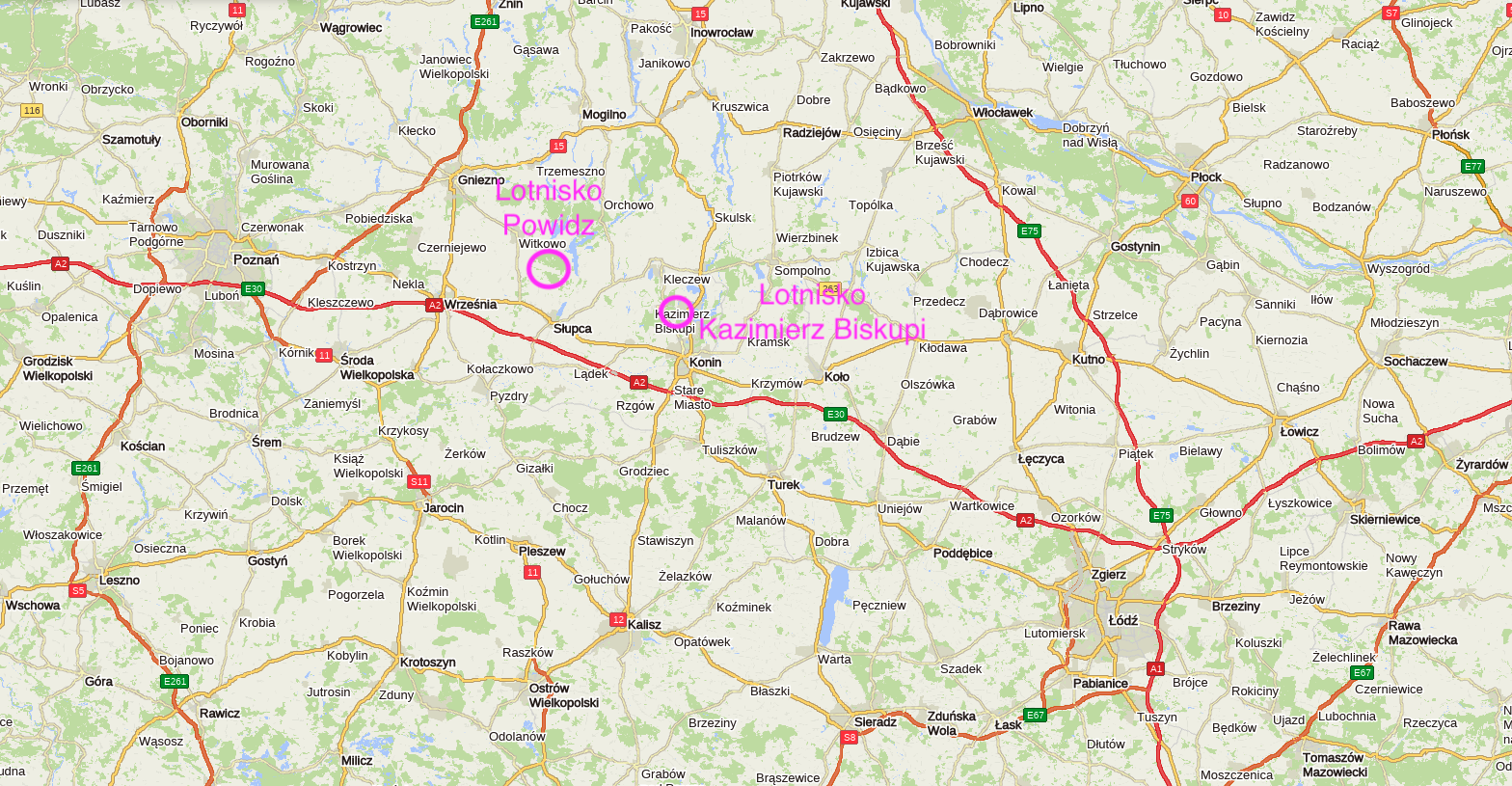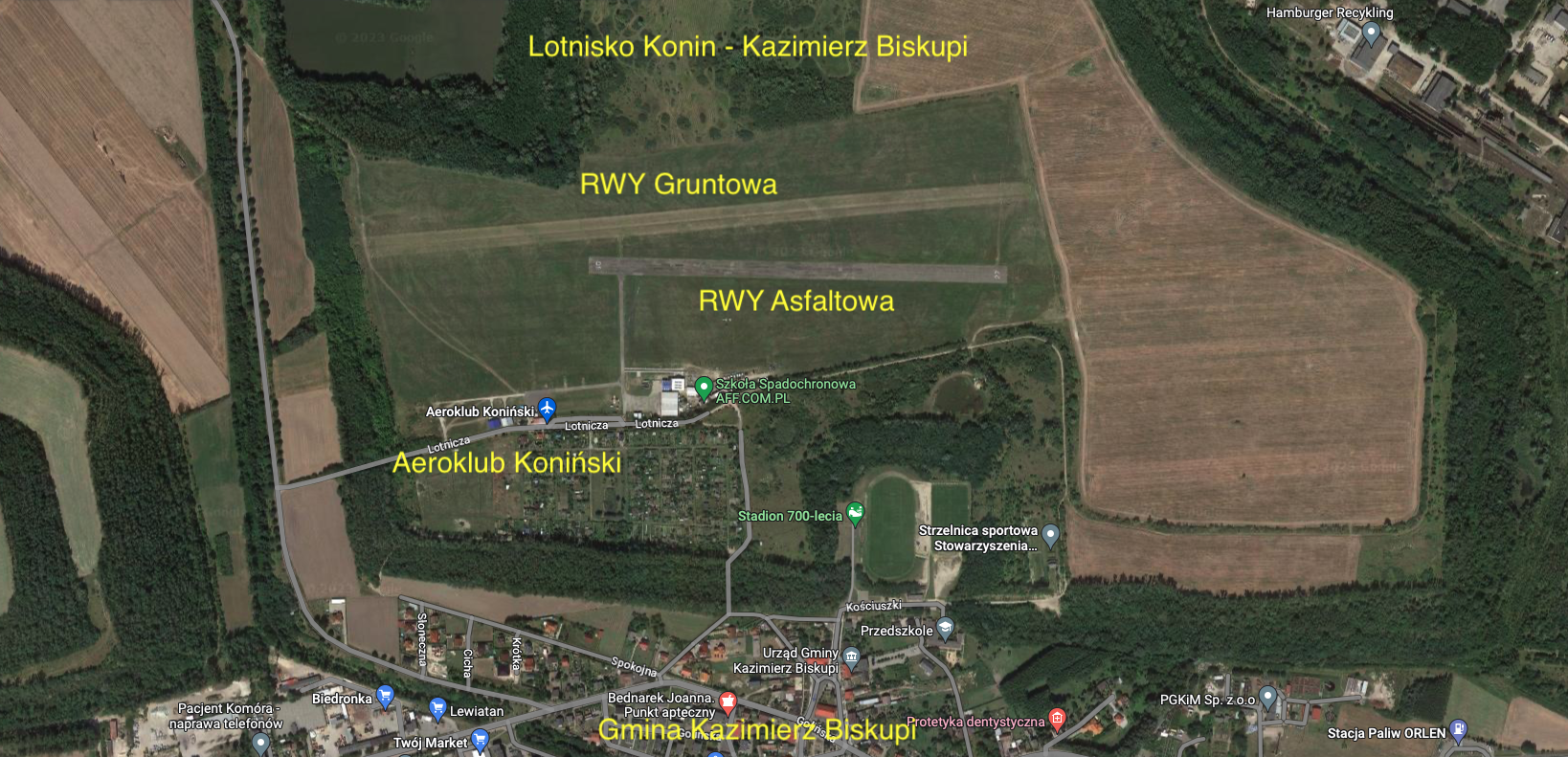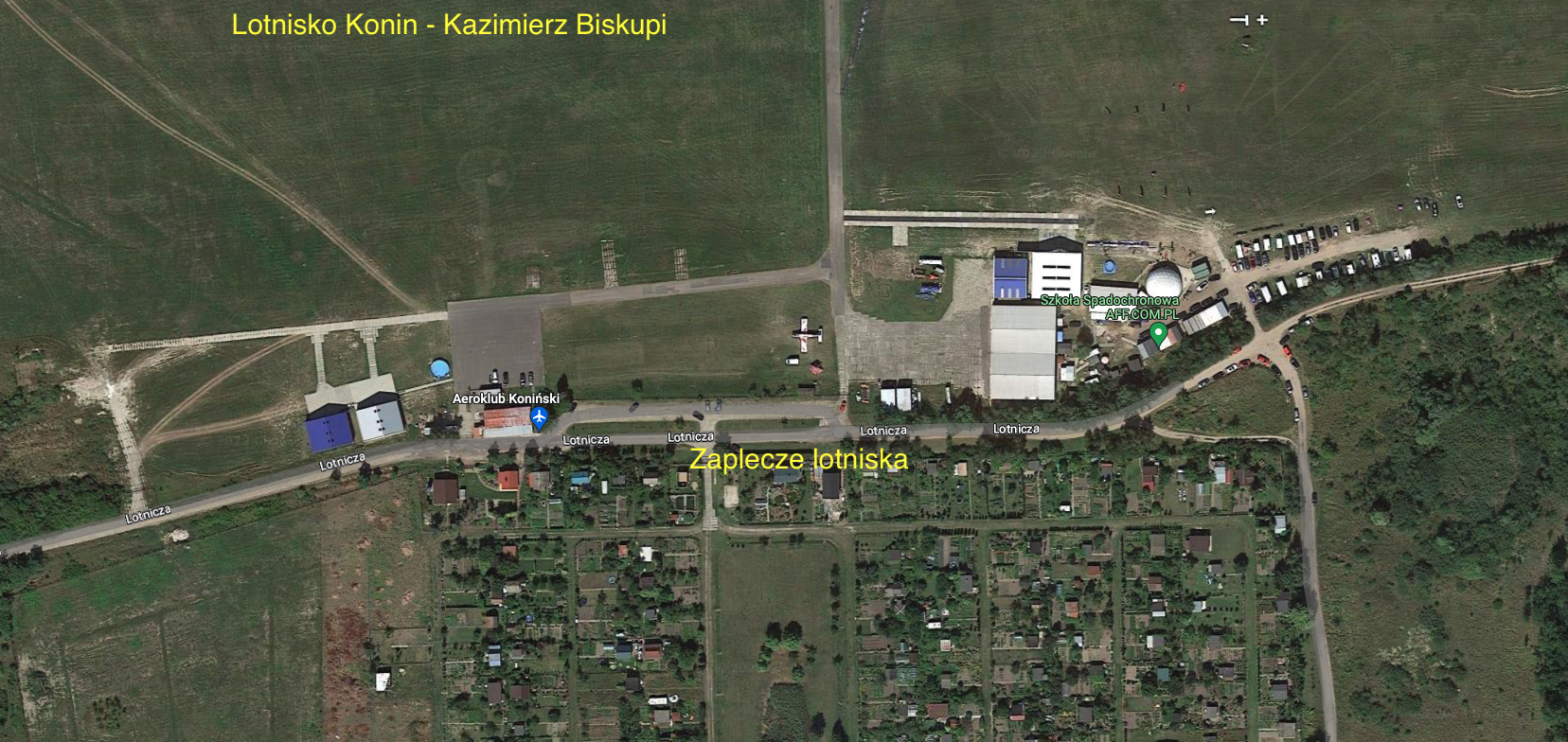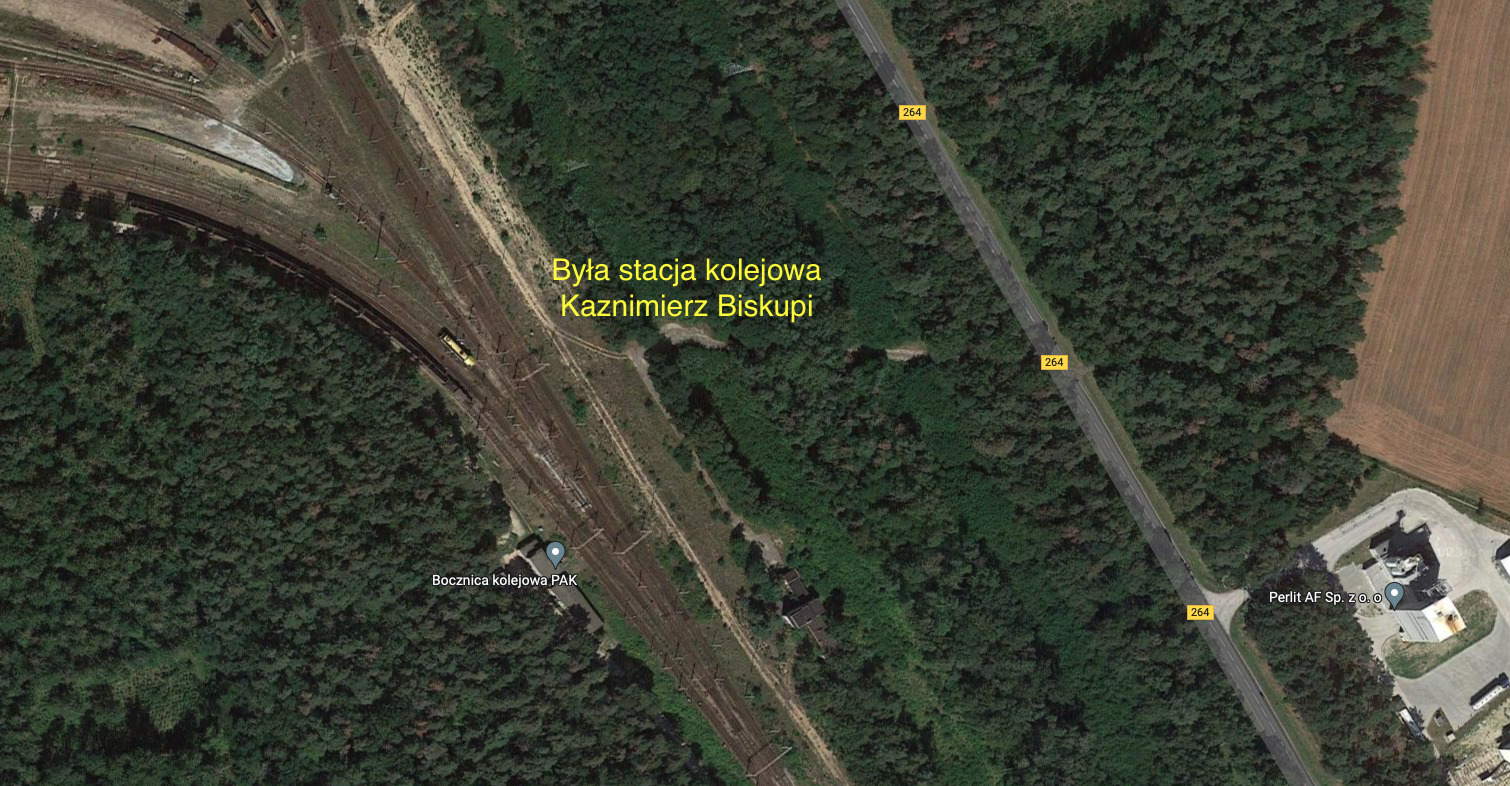Kazimierz Biskupi 20223-01-28
Lotnisko w Kazimierzu Biskupim koło Konina.
Współrzędne geograficzne: 52.319N 18.167E.
Kazimierz Biskupi.
Kazimierz Biskupi to jest miejscowość położona w województwie wielkopolskim, powiat Konin. Odległość do Konina wynosi 13 km, do Poznania jest 91 km, do Gniezna jest 55 km, do Łodzi jest 120 km, do Warszawy jest 212 km. Kiedyś Kazimierz Biskupi miał prawa miejskie, które otrzymał w 1287 roku. Miasto otrzymało prawo targowe i prawo jarmarków świątecznych. Za fundatora miejscowości uznaje się Kazimierza Odnowiciela. W XIII wieku, miejscowość należało do biskupstwa lubuskiego. Miejscowość funkcjonowała dzięki rolnictwu. W XIV wieku, do miasta należało 15 wsi. Był tutaj duży majątek ziemski. Miejscowość zasłynęła w średniowieczu, jako miejsce kultu Pięciu Braci Męczenników. Odległość od dóbr lubuskich spowodowała, że miasto zostało sprzedane szlachcicom w XVI wieku. W czasie wojen szwedzkich (1655-1660,1701-1721) Kazimierz Biskupi znalazł się na szlaku przemarszu wojsk, co spowodowało duże zniszczenia. Miasto nawiedzały pożary i zarazy. W XVI i XVII wieku, duże znaczenie w życiu gospodarczym Kazimierza Biskupiego odgrywało rzemiosło: branża tekstylno-odzieżowa, skórzana, spożywczo-przetwórcza, obróbki drewna i rolnictwo, które zawsze było dominujące. W 1793 roku, po II rozbiorze Polski, Kazimierz Biskupi znalazł się pod zaborem pruskim. W latach 1807-1815, należał do Księstwa Warszawskiego, a od 1815 roku, znajdował się pod zaborem rosyjskim. W okresie 1794 – 1864, Kazimierz Biskupi był prywatnym miastem szlacheckim. Stanowił ośrodek dużych dóbr ziemskich należących do różnych rodzin. Prawa miejskie zostały odebrane w 1870 roku, przez carat. Jednak pozostawiono prawo targów i jarmarków. Na czele stał wójt z radą gminy. W okresie międzywojennym nadal rozwijało się rolnictwo i rzemiosło. W 1925 roku, było 10 sklepów kolonialnych, 6 piekarni, 4 masarnie. Gmina nigdy nie była bogata, a jednym z powodów było oddalenie od głównych szlaków handlowych. Zabudowa była głównie drewniane i gliniano-słomiana. W czasie okupacji germańskiej (1939 – 1945) w pobliskich lasach niemcy wymordowali co najmniej 8 000 osób, głównie Polaków i Żydów. W 2010 roku, populacja liczyła 4 419 osób.
Powojenny rozwój, Kazimierz Biskupi i cała gmina, zawdzięczają przede wszystkim Kopalni Węgla Brunatnego „Konin”. W 50-latach XX wieku, w pobliżu miejscowości i dalszych okolic odkryto duże pokłady węgla brunatnego. W 1962 roku, rozpoczęto budowę odkrywki węgla brunatnego „Kazimierz”. Odkrywka zajęła północną część wsi. Pierwszy węgiel wydobyto w 1964 roku. Wydobycie węgla z tej odkrywki trwało przez 47 lat (1964 – 2011). Obecnie (2023 rok) odkrywa ta już nie istnieje.
Lotnisko Konin – Kazimierz Biskupi.
Współrzędne geograficzne: 52.319N 18.167E. Elewacja 110 m (362 ft).
Lotnisko znajduje się w odległości 14 km od Konina, w kierunku północnym. Na zachód od lotniska Konin – Kazimierz Biskupi, w odległości 25 km znajduje się 33. Baza Lotnictwa Transportowego w Powidzu.
Lotnisko zostało otwarte w 1986 roku, jako lotnisko cywilne – sportowe. Lotnisko posiada kod ICAO – EPKB. Właścicielem lotniska jest Aeroklub Koniński. Pole wzlotów powstało na zrekultywowanej hałdzie Kopalni Węgla Brunatnego „Konin”. Dojazdem na lotnisko jest ulicą Lotnicza, której nawierzchnia jest wyłożona trylinką. Ulica wznosi się ostro w górę na szczyt byłej hałdy. Teren lotniska jest ogrodzony i posiada kilka bram. Od południa z lotniskiem graniczy osiedle domów jednorodzinnych.
Aeroklub prowadzi sekcje samolotową, szybowcową, spadochronową, modelarską i balonową. Prowadzone są także loty widokowe, samolotem lub szybowcem. W 2014 roku, w Kazimierzu Biskupim założono stowarzyszenie wspierające sport spadochronowy – Spadochronowy Klub Sportowy Sky Camp. Organizowane są kursy spadochronowe, skoki grupowe, skoki z dużych wysokości, skoki turystyczne w tandemie.
Lotnisko dysponuje twardym RWY z nawierzchnią asfaltową, o wymiarach 640 m x 27 m, który jest położony na kierunku 091/271 (09/27). Wyznaczony jest także drugi RWY, o nawierzchni gruntowej (trawa) 1 020 m x 35 m, który jest położony na kierunku 085/265.
Adres: ul. Lotnicza 14, 62-530 Kazimierz Biskupi. Radio: Kazimierz-Radio 122.380 MHz. Telefon: +48 63 241 13 79.
Stacja kolejowa Kazimierz Biskupi.
Współrzędne geograficzne: 52.318N 18.193E.
W 20-latach XX wieku, Kazimierz Biskupi uzyskał połączenie kolejowe z Koninem. Zbudowano wówczas lokalną kolej wąskotorową. Konin otrzymał połączenie z Anastazewem i Sompolnem. Linie zbudowano dla obsługi rolnictwa, a zwłaszcza Cukrowni Gosławice. Do Gosławic linia kolejowa dotarła w 1912 roku. Podczas wielkiej wojny światowej, prusacy dobudowali następne odgałęzienia. Jedna z tych linii, Konin – Czarków funkcjonowała do 1965 roku, kiedy została rozebrane dla odkrywki węgla brunatnego (odkrywka Kazimierz Południe). Pierwszy pociąg kolei wąskotorowej na trasie Konin – Kazimierz Biskupi przejechał w dniu 22 grudnia 1925 roku.
Kiedy budowano wielkie kopalnie węgla brunatnego i wielkie elektrownie, państwo stanęło przed problemem dowozu pracowników. Komunikacja autobusowa, realizowana przez zakłady pracy była niewystarczająca. Należało sięgnąć po kolej.
Stacja kolejowa Kazimierz Biskupi został otwarta w 1974 roku, a jej zamknięcie nastąpiło w 1996 roku. Stacja miała jeden peron wyspowy z dwiema krawędziami. Obecnie stacja jest bocznicą kolejową ZE PKA (Zespół Elektrowni Pątnów – Adamów – Konin). W 1971 roku, na stacji kolejowej Konin zbudowano Peron 3. Peron umieszczono z północnej strony równi stacyjnej, czyli daleko od dworca. Do Peronu 3 przedłużono tunel pod torami i peronami dla podróżnych. Rozbudowano lokomotywownię na potrzeby zwiększonego ruchu. Linie kolejową Nr 388 poprowadzono wzdłuż drogi krajowej Nr 25. W dniu 26 maja 1974 roku, ze stacji Konin ruszyły pierwsze pociągi osobowe do Kazimierza Biskupiego.
Powstanie stacji było związane z linią kolejową Nr 388. Linia ma znaczenie przemysłowe i jest na usługach kopalni i elektrowni ZE PAK (Zespół Elektrowni „Pątnów-Adamów-Konin”) ZE PAK to jest zespół trzech elektrowni cieplnych opalanych węglem brunatnym i biomasą w Konińskim Zagłębiu Węgla Brunatnego, dostarczających 1 168 MW mocy. Elektrownie węglowe wchodzące w skład spółki zostały wybudowane w okresie 1958 – 1974. Elektrownia Konin uruchomiona została w 50-latach XX wieku. Elektrownia Adamów uruchomiona została w 1964 roku. Pierwszy blok w Elektrowni Pątnów I uruchomiony został w 1967 roku. Elektrownia Pątnów II oddana została do eksploatacji w 2008 roku. W 1970 roku, elektrownie Pątnów, Adamów i Konin zostały połączone organizacyjnie w Zespół Elektrowni Pątnów-Adamów-Konin, a w grudniu 1994 roku, Przedsiębiorstwo Państwowe ZE PAK przekształcone zostało w jednoosobową spółkę akcyjną Skarbu Państwa. W okresie 1995 – 1999 przeprowadzono restrukturyzację i prywatyzację, a w 1999 roku, inwestorem strategicznym ZE „PAK” SA został Elektrim SA. W wyniku przeprowadzenia restrukturyzacji w 1999 roku wyodrębniono siedem spółek zależnych.
Linia kolejowa Nr 388 łączyła miasto Konin z poszczególnymi elektrowniani cieplnymi w Zagłębiu Węgla Brunatnego i kończyła się na stacji Kazimierz Biskupi. Długość szlaku kolejowego Nr 388 wynosiła 14,226 km. Lina została zbudowana w okresie 1971 – 1974. W 1974 roku, nastąpiło jej uroczyste otwarcie. Uruchomiono pociągi towarowe oraz osobowe dla mieszkańców okolic i pracowników elektrowni i kopalń. Ruch osobowy zawieszono w 1996 roku. Stacje i przystanki na szlaku Nr 388: Konin – Konin Niesłusz – Konin Marantów – Maliniec – Konin Elektrownia – Gosławice – Pątnów – Pątnów Elektrownia – Kazimierz Biskupski. Linia Nr 388 rozpoczyna się we wschodniej głowicy stacji Konin i odbija od linii kolejowej Nr 3 w lewo w kierunku północnym. Biegnie równolegle z ulicą Torowa. Przecina ulicę Ignacego Paderewskiego w poziome jezdni. Dalej biegnie równolegle do Drogi Krajowej Nr 25 i rurociągu ciepłowniczego. Przecina ulicę Gajowa i kolejną przecznicę. W pobliżu Jeziora Turkusowego i ulicy Brunatna, była kiedyś stacja kolejowa Maliniec.W pobliżu elektrowni Konin rozpoczyna się równoległy szlak kolei przemysłowych. Tutaj jest przecznica ulicy Ksiądz Dominika Jędrzejewskiego. Kolej przemysłowa jest położona na nasypie, w szlak Nr 388 w poziomie jezdni (DK Nr 25). Podobnie jest w przecznicy ulicy Gosławicka. Na przesmyki Jeziora Pątnowskiego i Jeziora Gosławskiego jest węzeł kolejowy. Za przesmykiem tory obu kolei skręcają na zachód. Po minięciu Elektrowni Pątnów oraz skręceniu w kierunku północno-zachodnim i minięciu drogi wojewódzkiej Nr 264 jest bocznica ZE PKA, na której była stacja kolejowa Kazimierz Biskupski. Ze stacji do miejscowości Kazimierz Biskupski jest około 1 800 m, a do lotniska kolejne 600 m.
Planowano zelektryfikować Linie Nr 388, w okresie 1996 – 2000. Jednak z uwagi na zamknięcie jej dla ruchu pasażerskiego, planów nie zrealizowano. Także nie przedłużono linii dalej na północ, przez Klechów do Orchowo, gdzie połączyłaby się ze szlakiem do Inowrocławia.
Obecnie (2023 rok) linia Nr 388, ma długość 9,213 km, jest jednotorowa i niezelektryfikowana. Do 1996 roku, linia miała długość 14,226 km i prowadziła do Kazimierza Biskupiego. W połowie 1974 roku, na linię wyjechał pierwszy rozkładowy pociąg osobowy, a ruch pasażerski utrzymał się do maja 1996 roku. Od tego czasu na linii występuje tylko sporadyczny ruch towarowy. W założeniach linia miała połączyć dzielnice przemysłowe Konina z centrum miasta. W 2013 roku, szlak został wykreślony z wykazu linii kolejowych PKP PLK i przekształcona w ciąg bocznicowy Konin – Pątnów, tor 1P.
Co ciekawe, ruch na linii Nr 388 był ograniczony. Nie prowadzono ruchu kolejowe w nocy od godziny 22;00 do godziny 06;00 oraz w niedziele i w święta. W 1974 roku, kursowało 12 par pociągów. Najwięcej pociągów kursowało w 1985 roku, bo aż 14 par. Były także skrócone relacje Konin – Maliniec. W 1996 roku, były zaledwie 2 pary pociągów, a zdarzały się także ich odwołania. Czas przejazdu wynosił około 30 minut, choć w 90-latach przekraczał nawet 45 minut, z uwagi na ograniczenia. Wiele osób przesiadało się wówczas na własne samochody lub busy.
Koleje Górnicze KWB Konin i KWB Adamów.
Koleje Górnicze KWB Konin to są koleje przemysłowe, które obsługują kopalnie węgla brunatnego i elektrownie cieplne. Obok Kolei Górniczej KWB Adamów są szczególnym przypadkiem sieci kolejowej w Polsce. Podobnie było z Koleją Piaskową na Górnym Śląsku. Długość linii KWB Konin wynosi 120 km. Rozstaw torów normalny, 1 435 mm. Linie są zelektryfikowane. Napięcie w sieci trakcyjnej nietypowe w Polsce, 2 400 V DC. Prędkość szlakowa do 60 km/h. Kolej Górnicza KWB Adamów ma długość 30 km i podobne cechy jak KWB Konin.
Koleje Górnicze KWB Konin powstały pod koniec 50-lat XX wieku. Początkowo Koleje Górnicze KWB Konin były wąskotorowe (900 mm). W 60-latach zmieniono rozstaw na normalny. Koleje Górnicze KWB Konin mają wspólny punkt z koleją PKP (linia Nr 388) poprzez punkt zdawczo-odbiorczy na stacji Przesmyk-Gaj KWB. Kolej Górniczej KWB Adamów nie ma połączenia z koleją PKP.
Szlaki Kolei Górniczych są w większości dwutorowe. Pociąg węglowy składa się z elektrowozu i 10 wagonów samowyładowczych. Na szlakach KWB Adamów są składy 8 wagonów. Ruch kolejowy na Kolejach Górniczych prowadzony jest w oparciu o przepisy zakładowe, zatwierdzone decyzją Urzędu Transportu Kolejowego, a wynikające z przepisów kolejowych obowiązujacych w PKP. Niektóre pociągi poruszając się jako składy pchane. Pierwszy wagon wyposażony jest w kamerę przemysłową, komplet świateł oraz dzwonek ostrzegawczy. Podstawową lokomotywą Kolei Górniczych jest niemiecki elektrowóz typu LEW EL2, nazywany „Krokodyl”, który w 60-latach XX wieku, zastąpił wąskotorowe lokomotywy LEW EL3 (rozstaw 900 mm). Dla celów ruchu manewrowego eksploatowane są lokomotywy spalinowe: SM48, SM42, SM30, 401Da, SM04. Węglarki są samowyładowcze typu VAP, 407V oraz 410V. Z uwagi na dużą wilgotność węgla brunatnego i możliwość oklejania się węgla w wagonach, węglarki są ogrzewane.
Ostatni pociąg z węglem przyjechał do Elektrowni Adamów w dniu 30 grudnia 2017 roku. W 2019 roku rozpoczęto likwidację linii kolejowych KWB Adamów.
Opracował Karol Placha Hetman




